Abstract
The structural properties of selected (Ba1−xSrx)PbO3 ceramics were examined at 14–1148 K using X-ray powder diffraction (XRD). These materials are attractive due to their variety of applications, such as, for example, high-temperature thermoelectric energy conversion. Attention was paid to this paper as a continuation of the previous examinations of higher Sr2+ concentrations. The type of perovskite distortion and temperatures of the structural phase transitions (SPTs) were determined from the splitting of certain pseudocubic lines. At this point, for example (Ba0.3Sr0.7)PbO3 showed three temperature-induced SPTs. When the amount of Sr increased in the samples, no phase transition was observed, which is contrary to the data previously demonstrated in the literature. The quality of the ceramics was examined by scanning electron microscopy-energy dispersion X-ray spectroscopy (SEM-EDS), demonstrating their homogeneity and uniform elements dispersion. As a result of profound crystal investigations, confirmed by thermogravimetric analysis and quadrupole mass spectroscopy (TGA-QMS), a phase diagram was prepared for the (Ba1−xSrx)PbO3 system based on our former and recent study. Also, the investigation of a new application for the (Ba1−xSrx)PbO3 family is presented in this paper for the first time. The TGA analysis was conducted on Illinois#6 hard coal to evaluate the capability of perovskites to be used in the chemical looping combustion (CLC) process in a range of temperatures 1073–1173 K. Due to its thermal stability and reactivity, Ba0.9Sr0.1PbO3 is the material with the greatest potential to be applied as an oxygen carrier. The combination of strontium and barium offers encouraging results compared to the pure barium and strontium lead oxide perovskites.
1. Introduction
Today, there is increasing attention towards perovskite-type materials [1,2,3,4,5]. This is mainly due to their excellent properties and practical applications. Many of these materials have interesting properties such as ferroelectricity or ferromagnetism (used as sensors and data storage devices) [6], etc. Furthermore, they are used as supercapacitors for electrochemical energy storage (batteries and electrochemical capacitors) [7,8,9]. Some have successfully been used as perovskite solar cells (PVSCs) [10,11,12,13] due to their remarkable efficiency increase of nearly 24% compared to commercial Si solar cells [1], or ceramic foam membranes for oxygen [2] or carbon dioxide transport [14]. Others have been used as superior perovskite electrocatalysts [15], possessing multiferroic properties together with polarization-induced photoelectrochemical activity, for water splitting applications [16]; and as so-called oxygen carriers in energy-generation processes [17,18,19] due to the reversible and fast change of oxygen content for many cycles at high temperatures. When external conditions such as temperature or pressure are used, changes in their physical or structural properties are observed [12,20]. The perovskite structure is most commonly found for compounds with a general ABX3 formula. An A is commonly a metal with a +1 or +2 oxidation state, B is a metal with a +3, +4, or +5 oxidation state, while an X is an anion, most often an oxide or fluoride.
Research into changes in the structure and physical properties of perovskites are relevant for their further industrial application. Doping perovskites with certain metals could alter their structure; also, the admixture of certain materials can improve their stability under certain conditions, such as high temperatures, preventing unfavorable changes in structure, which could be important if the material is applied to work in a wide range of temperatures. Proper composition allows the material to maintain its properties in such an environment [21,22,23].
Among the interesting examples of perovskites, (Ba1−xSrx)PbO3 compounds can be highlighted. The reason for this is their variety of applications, such as high-temperature thermoelectric energy conversion, as reported in [7,9,24,25,26]. Furthermore, they may be applied to prevent the corrosion of long-life batteries, which are usually coated with oxide layers of SrPbO3 [27].
Shannon et al. [28] reported an orthorhombic Pbnm symmetry for SrPbO3 ceramic, while Keeler et al. [29] analyzed the observed Pnma space group of SrPbO3 monocrystals with a = 5.964 Å, b = 8.320 Å, c = 5.860 Å. Furthermore, Fu and Ido proposed re-examining its structure in response to Ritter’s paper [30]. They applied the powder neutron diffraction technique and estimated the tilt angles of the octahedra tilting in the [110]c and [001]c directions as 15.1° and 11°, which was noted as a−a−c+. Then, Shuvaeva et al. [31] for SrPbO3 at 298 K reported a monoclinic distortion of perovskite cells with the following pseudocubic cell parameters: ac = cc = 4.17 (6) Å, bc = 4.16 (6) Å, β = 90°53′. There is a good agreement on the crystal structure of SrPbO3 (Pnma, or Pbnm) at room temperature, even when different techniques are applied [29,32,33,34,35].
Only partial information is available for SrPbO3-doped materials, such as (Ba0.8Sr0.2)PbO3 and (Ba0.3Sr0.7)PbO3 ceramics. An assumed symmetry of Imma is reported as well as pure BaPbO3 [32,36]. Moreover, a high-temperature behavior study for undoped SrPbO3 showed very different results. For example, in paper [29], the transition from the orthorhombic to the cubic phase was observed at about 1123 K. In another paper [35], a tetragonal phase transition was observed at 723 K. Based on the splitting of the main diffraction line of the {211} type, the authors also suggested a possible cubic phase transition close to 1023 K. However, they did not observe it during the examinations. Therefore, Hester et al. [32] investigated the crystalline structure of the SrPbO3 compound by X-ray diffraction in the 298–1033 K range. He was skeptical of the report of Keester et al. [37]. The obtained results showed that in the studied high-temperature range, the observed symmetry was Pnma. He suggested that if a structural transition was present, it would be Pnma-Imma, due to the change in the type of PbO6 octahedral tilting from a+b−b− to a0b−b−. Moreover, only a few works have been published on the study of crystalline structure at low temperatures, but they only concern the BaPbO3 perovskite [38,39].
The literature on related perovskite series (Ba1−xSrx)PbO3 is limited. Principally, this is because the reports discuss the application of pure SrPbO3 and BaPbO3 and their crystal structure. There is no information on the crystalline structure of the mixed (Ba1−xSrx)PbO3 compounds, both at room temperature and at low and high temperatures. Therefore, it is necessary to precisely describe the crystalline structure of compounds based on SrPbO3, where strontium ions are substituted with barium ions.
Understanding where physicochemical values like material composition, temperature or pressure, and certain phase transitions overlap is helpful for developing more stable materials that are able to work under a broader range of physical conditions, which is particularly important in applications like solar energy devices, sensors [22], or high-temperature solid oxide fuel cells [40,41]. In view of the uncertainties in the published data, a redetermination of the phases of (Ba1−xSrx)PbO3 was carried out.
The aim of this work is to determine both the crystalline structure at RT and evaluate the potential structural phase transitions of (Ba1−xSrx)PbO3 ceramics as a function of temperature, from as low as 14 K to 1143 K. Furthermore, the description of the mechanism responsible for the distortions of the observed structures in the examined perovskites is a key issue. In the present work, the powder X-ray diffraction (XRD) method was applied to determine the parameters of the crystalline structure parameters. On this basis, the phase composition, symmetry, distortion, and the potential presence of structural phase transitions were determined. The purity and homogeneity of the obtained ceramics were additionally examined with scanning electron microscopy combined with an energy dispersion X-ray spectrometer (SEM-EDS). To support the observed phenomena, simultaneous thermogravimetry—differential scanning calorimetry (STA/TG-DSC) coupled to a quadrupole mass spectrometer (QMS)—was additionally applied. To test the perovskites’ potential application in chemical looping combustion (CLC) processes, a TGA study was also carried out using the Illinois#6 hard coal and the synthesized materials.
2. Materials and Methods
2.1. Synthesis of (Ba1−xSrx)PbO3 and the Materials Quality Examination
The research presented in this paper is a natural continuation of the research work of our group on barium-strontium ceramics [20,42]. As a result, the focus here was placed on a higher concentration of strontium in the samples.
Samples of the (Ba1−xSrx)PbO3 series were obtained from BaCO3, SrCO3 and PbO2 powders (>99.9% POCH; Sigma Aldrich, St. Louis, MO, USA). Stoichiometric amounts of the starting materials were thoroughly ground and pelletized (15 × 5 × 5 mm at 20 MPa) and then heated in flowing air at 1073 K for 20 h. The pellets were then reground, remixed, re-pelleted, and heated again in the air at 1223 K for 15 min. The resulting material was ground and sieved. The optimal calcination conditions were selected based on pre-testing. The formation of perovskite compounds was confirmed by X-ray diffraction [20,42].
The microstructure of the material surface was studied using scanning electron microscopy by means of a JEOL JSM—6610 LV (Tokyo, Japan) instrument with an energy dispersion X-ray spectrometer for chemical microanalysis purposes. The surface morphology was studied by gluing carbon tape onto the samples; carbon tape was not used in the chemical analysis of the samples. The study was carried out using a low vacuum detector at an accelerating voltage of 15 kV and different magnifications of the image (50–1500×). EDS with a Si(Li) X-ray detector (Oxford Instruments, Abingdon, UK) was used to investigate the homogeneity of the samples. Microphotographs, of a 250× magnification of (Ba1−xSrx)PbO3 perovskites powders, are shown in Figure 1. The ceramic powders were fine and dense, with a grain size estimated at 15 microns for those with Sr2+ concentrations from 0.5 to 1. For concentrations of x ≤ 0.5, some bigger grain sizes, ca. 50 microns, were observed. The composition analysis by EDS showed no presence of impurities in the final ceramics, for example, as seen in Figure 2. The mapping analysis carried out proved that the obtained samples were homogeneous with a uniform distribution of atoms. An example of SrPbO3 mapping specifically for Sr, Pb, and O elements is shown in Figure 2b.
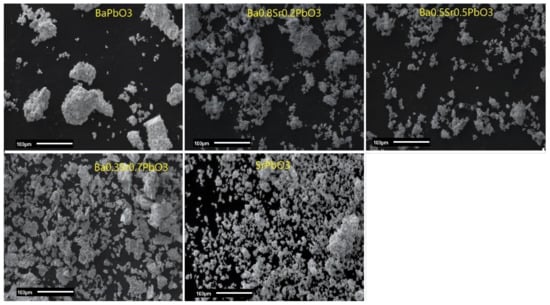
Figure 1.
SEM images of (Ba1−xSrx)PbO3 series surface at 250× magnification.
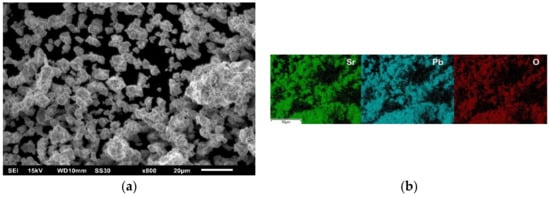
Figure 2.
SEM image of SrPbO3 powders registered at 800× magnification (a), example of distribution maps of Sr, Pb and O ions (b).
The perovskite crystals belong to a group of ionic compounds. The structure of the ideal perovskite with the general formulae of ABX3 is a regular cell with the atoms occupying specific positions, which are A+: 000, B+: ½ ½ ½, and X−: ½ ½ 0, ½ 0 ½, 0 ½ ½. For the prediction of the formability of the perovskite structure and its stability, a tolerance factor (τ) was calculated according to the procedure shown elsewhere [13]. For calculating the Goldschmidt factors for (Ba1−xSrx)PbO3 ionic radii, RSr2+ = 1.44 Å, RBa2+ = 1.61 Å, RPb4+ = 0.775 Å, RO2− = 1.35 Å were applied. If this factor is equal to unity, it means that all ions touch each other, and this perovskite is called an ideal. In such a perovskite, usually no structural phase transitions are observed. It is also identified that the crystalline structure is stable when the factor is in the range of values: 0.8 < τ <1.0. The estimated value of the tolerance factor for SrPbO3 is 0.928, and when some Ba ions are introduced to the lattice—for example for (Ba0.2Sr0.8)PbO3 and (Ba0.3Sr0.7)PbO3—it increases to 0.940 and 0.945, respectively. Therefore, from a geometric point of view, stable performance at high temperatures is expected.
2.2. X-ray Diffraction (XRD) Analysis
The phase identification and determination of cell parameters of selected (Ba1−xSrx)PbO3 samples were performed using a Siemens D5000 X-ray powder diffractometer (Munich, Germany), with Bragg–Brentano geometry (θ-θ), 40 kV, 25 mA, filtered CuKα radiation of λ = 1.54056 Å, a step of 0.02°, 10 s per step, 2θ from 10 to 150°, and a temperature from 14 to 1148 K ± 1 K. Because of the construction of the X-ray diffractometer, the data were collected in the high-temperature range from 298 K to 1148 K and below room temperature from 298 K to 14 K using high-resolution cameras HTK 1200 and He TTK, respectively (Anton Paar, Graz, Austria). Selected pseudocubic lines were measured with 20 and 25 K steps at low and high temperatures, respectively. The analyzed lines contained pseudocubic lines {200}c, {110}c, {220}c, {310}c and {222}c. Apart from the main diffraction lines, the superstructure lines were analyzed. The X-ray Powder Reflection Profiler (XP, Poland) program was used for splitting the overlapping diffraction lines and determining their intensity and position. These data were useful for the calculation of the cell parameters for each temperature by the application of the Checkcell program. For Rietveld analysis, the FullProf program was used, which enables structure profile refinement for selected temperatures. Chemical phase analysis was carried out using the International Data for Diffraction Data (JCPDS-ICDD) database. In addition, the crystallite size was determined using a RIGAKU MiniFlex600 powder X-ray powder diffractometer MiniFlex600 by RIGAKU (Tokyo, Japan). Experiments were carried out at 40 kV, 15 mA, filtered CuKα radiation of λ = 1.54056 Å, a step of 0.02°, 5 s per step, for 2θ range from 20 to 90°. The medium crystallite size was determined from about 20 reflections using a pseudo-Voigt profile. The estimated crystallite size varied for samples between 552 Å and 440 Å for undoped SrPbO3 and BaPbO3, respectively. As a result of ion substitution, an increase in crystallite size was observed—for example, the (Ba0.9Sr0.1)PbO3 material reached 467 Å.
2.3. Thermogravimetric Analysis (TGA)
Additional testing was aimed at supporting the XRD data. As a result, in this work, simultaneous thermogravimetry—differential scanning calorimetry, STA/TG–DSC, specifically using STA 449 F5 Jupiter apparatus by Netzsch (Selb, Germany)—was applied. In the experiments, the mass changes of the powdered strontium-barium-based perovskites were measured dynamically as a function of time and temperature. A circa 5 mg perovskite sample was placed in an alumina crucible and heated in a synthetic air atmosphere with a heating rate of 15 K/min, with a 25 mL/min flow rate. The sample was treated this way up to 1173 K. When a temperature of 1173 K was reached, the sample was slowly cooled down in oxidizing conditions with a cooling rate of 15 K/min. Mass changes and temperature changes were continuously registered during the experiment. As the STA analyzer cooled down, the samples were collected for post-experiment analysis, i.e., for determining crystal phase changes. In the experiment, working conditions were appropriately tailored by studying the effect of sample mass (5, 20, and 200 mg) and gas flow rates (10–125 mL/min). As a result, final sample masses and used gases rates were set.
Moreover, thermogravimetric experiments for fuel combustion were performed in a thermal analyzer (STA 449 F5 Jupiter (Netzsch, Selb, Germany)), which was paired to a QMS 403C Aeolos (Netzsch, Selb, Germany). The mass spectrometer can detect the mass number of gas in the range 1–300 amu in the MID mode. The analysis was carried out isothermally as a function of a time. The sample was heated from room temperature to requested temperatures (800, 850, and 900 °C; (1073, 1123, and 1173 K) with a heating rate of 20 K/min. The experiments contained two stages: the first was the fuel combustion process and the second was the regeneration of the reduced oxygen carrier with the application of synthetic air, with flow rate of 80 mL/min for 20 min.
For preliminary study, the graphite was chosen as a model fuel. For selected samples of oxide materials, i.e., an SrPbO3, BaPbO3, and (Ba0.9Sr0.1)PbO3 analysis of graphite combustion was conducted. The sample weighed in total approximately 100 mg with the 50% surplus of the perovskite and fuel. The samples were placed in an alumina crucible and heated up to the desired process temperatures. The mass changes were analyzed in parallel with the gas analysis. When the process was completed, the samples were collected for the post-analysis. Afterwards, the targeted experiments contained the Illinois#6 hard coal. The Illinois#6 American hard coal was used as combustion fuel in this investigation. The characteristics of the Illinois#6 hard coal [43] are revealed in Table 1.

Table 1.
Composition of Illinois#6 hard coal.
3. Results and Discussion
Below, the comprehensive data on the crystal structure of selected perovskites are included. A detailed study for SrPbO3 and (Ba0.2Sr0.8)PbO3 and (Ba0.3Sr0.7)PbO3 is shown as an example, and for other samples, data were included in summarizing figures.
3.1. SrPbO3 Crystal Structure at Room Temperature (RT)
SrPbO3 perovskite has received considerable attention in recent decades due to its outstanding properties and applications, as mentioned previously. In this paper, SrPbO3 crystalline structure evolution was studied with XRD, which was performed over a wide temperature range at both low and high temperatures, i.e., from 14 K to 1148 K. In addition, for the first time, the crystalline structure was studied at low temperatures.
The type of distortion from an ideal cubic perovskite structure was determined using the diffraction lines splitting method and Glazer’s analysis, described elsewhere [20]. The pseudocubic distortion was determined, and cell parameters were calculated based on the splitting of the major selected diffraction lines, such as {200}c, {220}c, {222}c. Figure 3 shows the temperature evolutions of {220}c and {222}c reflections for selected 298 K, 723 K, and 1048 K temperatures. Figure 3 shows raw and fit data with Kα1 and Kα2 lines. Using data from the literature published elsewhere [20], the consideration of the number of main splitting diffraction lines and the analysis of the superstructure lines made it possible to solve the perovskite structure. Therefore, in this paper, the terminology used by Glazer for the classification of space groups and symmetries associated with each of the tilting types is applied. Based on the relationship between the number of major pseudocubic diffraction lines and the given crystallographic system, and the octahedra tilting type for given distortions [44], the distortions and perovskites symmetry were determined.
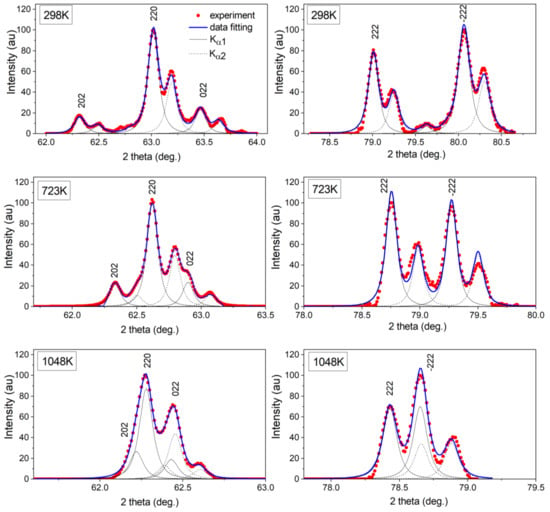
Figure 3.
Splitting of the main reflections {220}c and {222}c in the function of temperature for SrPbO3.
An analysis of the major diffraction lines at RT indicated the presence of three reflections of the {200}c type, three reflections of {220}c, and two of {222}c. It can be concluded that the SrPbO3 pseudocubic cell has three different cell parameters, i.e., ac ≠ bc ≠ cc. Furthermore, based on that information, the expected distortion is monoclinic. Both the intensity and the position of each measured line were fitted using the least-squares method with the application of the X-ray Reflection Profiler program, which further enabled the calculation of cell parameters.
The splitting of the main diffraction lines enabled the determination of the type of unit cell distortion, both at RT and high temperatures. Moreover, additional weak lines with half-Miller indices in the pseudocubic system were observed, as shown in Figure 4. Those lines are called superlattice lines, and the powder pattern data on their observation at RT are collected in Table 1.
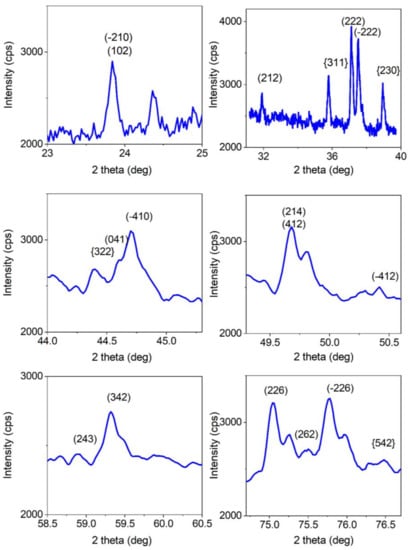
Figure 4.
Superstructure lines observed for SrPbO3.
Superlattice lines are obtained as a result of PbO6 octahedra rotations, called “in phase”, or “out of phase”. Their presence in the XRD pattern indicates if the final cell has a multiplied cell edge, according to Glazer’s theory [44]. The analysis of the superstructure lines showed the presence of both octahedral tilting in the same (+) and in the opposite (−) directions (Table 2).

Table 2.
Superstructure line indices and type of PbO6 octahedra tilting in SrPbO3.
The analysis showed that the monoclinic distortion of the SrPbO3 structure is caused by both Sr2+ cation displacements and by the twisting of the PbO6 anion octahedra. The indication for this is that some superstructure lines with odd-even-even parity Miller indices, such as (302) or (124), were observed in the X-ray powder pattern (Figure 4). This means that Sr2+ cations are shifted from their ideal positions toward the yz direction. However, the presence of (−311) or (113) superstructure lines with odd-odd-odd parity of indices (for h ≠ k and l ≠ k) is a readable proof for PbO6 octahedra tilting of the a- type, whereas (143), (−321), (501) with odd-even-odd parity of indices (for h ≠ l) is of the b+ type. In other words, the monoclinic distortion is caused by both the rotation of PbO6 octahedra about the [100] and [010] axes of the primitive cell and by Sr2+ cation displacement from their ideal positions. Therefore, two factors have influenced the cell distortion: the cation displacement and octahedra rotation. For that reason, for SrPbO3 ceramics, the a−b+a− notation can be applied. Those two factors and the observed ac ≈ cc ≠ bc parameter values lead to assigning them to the Pbnm group. As a result, the monoclinic distortion described by P21/m with an orthorhombic symmetry described by the Pbnm space group can be applied for the SrPbO3 perovskite.
The visualization of the described distortion of the ideal cubic perovskite cell for the SrPbO3 compound is shown in Figure 5. The crystal structure data for the sample at 298 K are shown in Table 3. From the analysis of Figure 5, rotations of oxygen octahedral are visible in three directions.
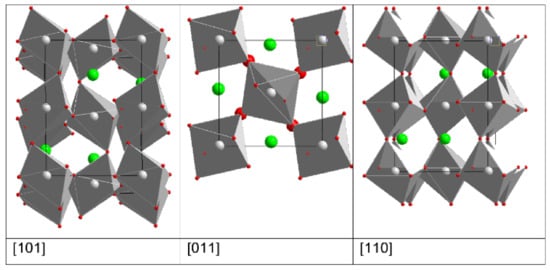
Figure 5.
SrPbO3 cell with Pbnm orthorhombic symmetry at 298 K. Projections on [101], [011], and [110] planes are shown. Red spheres—oxygen, grey spheres—lead, green spheres—strontium.

Table 3.
Structural parameters of SrPbO3 at RT and 14 K.
To exactly describe the crystalline structure of SrPbO3 at RT, the ceramic sample was subjected to XRD testing in the 10–150° 2θ range. The structural evolution of SrPbO3 was analyzed using the Rietveld method. As a result, Figure 6 shows the powder diffractogram for SrPbO3 obtained at room temperature. This shows the observed intensity (Yobs—red circles), which is the experimental data, the calculated intensity (Ycalc—black line), the difference in observed and calculated intensities (Yobs-Ycalc—blue line), and peak positions of the phase (green ticks). The calculated parameters of the elementary cell and the coordinates of the atoms are shown in Table 3. The data at room temperature can be successfully fitted using the orthorhombic Pbnm space group with good reliability factors. Based on the calculation, the symmetry is described as orthorhombic with the following refinement parameters RB = 5.89%, Rf = 6.29%, and χ2 = 0.347. It should be noted that the results obtained in this article are consistent with the literature shown elsewhere [30,31].
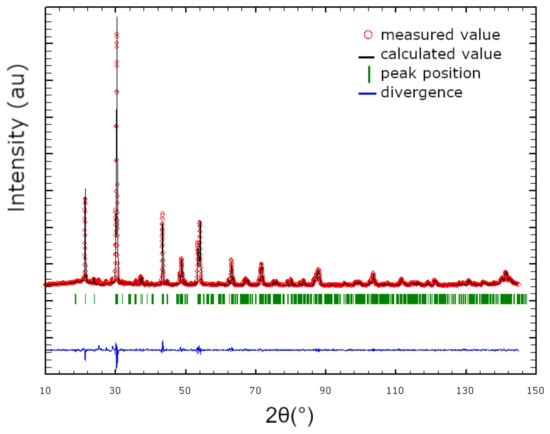
Figure 6.
Rietveld analysis results of X-ray powder diffraction pattern for SrPbO3 collected at RT.
3.2. SrPbO3 Ceramic Structure at High and Low Temperatures
Undoped SrPbO3 ceramic was exposed to high (from RT up to 1148 K) and low (from RT up to 14 K) temperatures. The temperature evolution of the selected diffraction lines is shown in Figure 3; it indicates the effect of temperature on the lattice parameters. The sample behavior is remarkable while processing at high temperatures. This behavior is opposite to the behavior of the previously examined oxide perovskite samples containing the PbO6 octahedral, i.e., BaPbO3 [20]. The temperature relationship of the SrPbO3 pseudocubic cell parameters is shown in Figure 7. It is clear that the cell parameters (ac, bc, cc, and β) change smoothly. In other words, they increase systematically with an increase in temperature up to 1093 K. The average error for cell parameters determination was ±0.0027 Å for a, b, and c; for β, it was ±0.05°; and for V, it was equal to ±0.07 Å3. Widely conducted temperature crystalline structure studies have shown that no structural phase transitions occurred between 298 K and 1093 K in the SrPbO3 sample. Instead of that, the continuous increase in cell parameters is accompanied by an increase in temperature (Figure 7). This is interesting since Keester et al. [37] reported observing an SPT, a tetragonal phase, that started at about 450 °C. For that reason, special attention was paid in this paper to the 700–770 K temperature range. An analysis of the line splitting showed the presence of three lines of {200}c and {220}c and two lines of {222}c at 723 K (Figure 3). This proves the monoclinic distortion of the perovskite cell. Therefore, this phase cannot be considered as a tetragonal phase since no evidence of the phase was observed. Furthermore, the continuation of high-temperature examinations (up to 1048 K) contradicts literature reports. The proof for this was the constant presence of three hh0 diffraction lines and two hhh lines. The linear change of the cell parameters (green squares, blue triangles, and red circles stand for ac, bc, cc, respectively) with increasing temperature was observed, with a clear demonstration that ac ≈ bc and their values were close to the cc values. The monoclinic angle (marked with stars). —β—tends to a value close to 90° Therefore, based on the observed behavior, a structural phase transition above the measured temperature of 1093 K can be expected. However, due to further heating, on the sample surface, Sr2PbO4 together with PbO was formed. Increasing the temperature inside the HT camera caused the progressive degradation of the sample, which was especially observed at 1148 K. Nevertheless, our study supported data provided by Hester [32], who observed a Pnma structure from 298 to 1033 K.
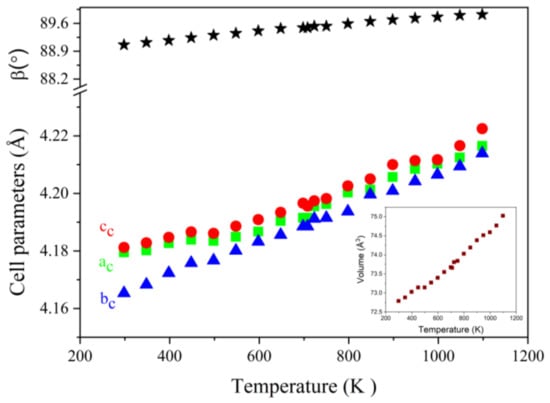
Figure 7.
Pseudocubic cell parameters in the function of temperature for SrPbO3. The inlet shows the temperature evolution of the cell volume.
As indicated previously, the crystal structure tests were also performed at low temperatures. The reason for that was that the structural transition to lower symmetry phases was expected to occur. The powder diffraction pattern as low as 14 K, together with Rietveld refinement data from X-ray powder diffraction, are shown in Figure 8 and Table 4, respectively. The analysis indicated that SrPbO3 has orthorhombic symmetry up to 14 K. It was also concluded that the crystalline structure of SrPbO3 at 14 K did not show significant differences with respect to the crystalline structure data obtained at RT. The structure can also be described as an orthorhombic Pbnm space group, and cell parameters are a = 5.836 (2) Å, b = 5.952 (3) Å, c = 8.294 (5) Å, V = 288.1 (4) Å3. As expected, a volume contraction was observed, and the temperature factor values decreased. Furthermore, small shifts of the Sr2+ cations from their ideal positions in the xy plane were observed, while for O2− additional shifts in the [001]c direction were observed.
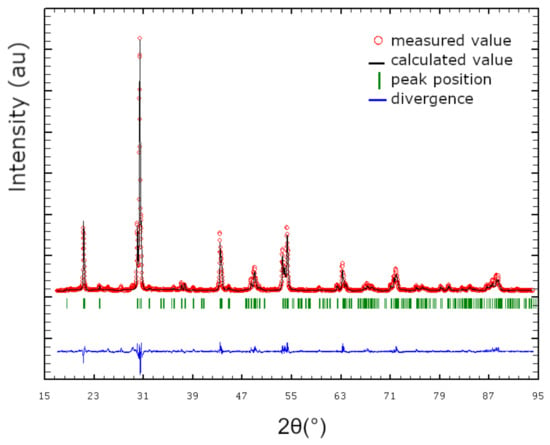
Figure 8.
Rietveld analysis results of X-ray powder diffraction pattern for SrPbO3 collected at 14 K.

Table 4.
Selected interatomic distances and angles and estimated tilting angles of PbO6 for BaPbO3, (Ba0.5Sr0.5)PbO3, and SrPbO3 compounds.
3.3. Doped Samples
3.3.1. (Ba0.2Sr0.8)PbO3 Ceramic Structure Both at RT and HT
Now, it is interesting to evaluate how the substitution of Sr by Ba ions influences the crystal structure. The selected samples contain both (Ba0.2Sr0.8)PbO3 and (Ba0.3Sr0.7)PbO3 ceramics. As a result of doping with Ba2+ to SrPbO3, (Ba0.2Sr0.8)PbO3 samples were produced. The crystalline structure of the (Ba0.2Sr0.8)PbO3 compound was studied in a similar manner, using an undoped sample for the same set of diffraction lines. Therefore, Figure 9 shows the thermal evolution of certain {200}c and {222}c lines at selected temperatures, i.e., at 298 and 1093 K. The analysis of the data showed that the structure has a monoclinic distortion, which is similar to that observed for undoped SrPbO3. That conclusion is supported by the presence of three lines of the {200}c type, which exist together with two lines of the {222}c type.
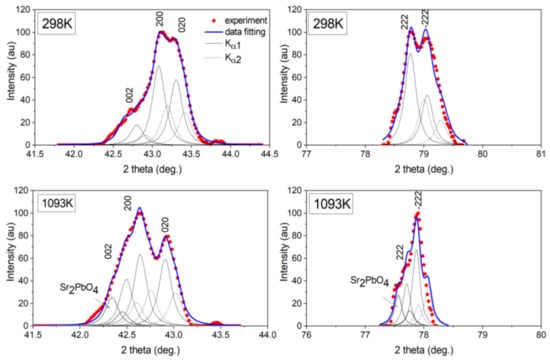
Figure 9.
Splitting of the main reflections {200}c and {222}c for (Ba0.2Sr0.8)PbO3 at RT and 1093 K.
At 298 K, the splitting analysis of the major diffraction lines indicates a monoclinic distortion of the cell. The reflections resulting from the octahedral tilting in the same direction (+) and in the opposite direction (−) were observed with the indicators for pure SrPbO3. For that reason, the tilting of the PbO6 octahedra can be summarized using Glazer’s notation as a−b+c−. Based on that, and following Woodward’s classification, the pseudocubic cell distortion of (Ba0.2Sr0.8)PbO3 can be described as monoclinic with the P21/m space group. An analysis showed that in the entire temperature range from 298 K to 1073 K, the (Ba0.2Sr0.8)PbO3 sample exhibited monoclinic distortion. Above 1073 K, a structural transition to the tetragonal or orthorhombic phase was expected due to the observable behavior of the cell parameters. However, the further temperature treatment of the sample resulted in the sample decomposition. At 1093 K, some Sr2PbO4 was produced on the surface of (Ba0.2Sr0.8)PbO3. It was proved by the XRD study that additional diffraction lines were observed at lower 2θ angles, supported by strontium orthoplumbate. This means that 1053 K would be the maximum temperature for its practical application without decomposing the Ba2+-doped sample. Figure 10 shows the temperature evolution of the pseudocubic cell parameters (green squares, blue triangles, and red circles stand for ac, bc, cc, respectively while stars for β) together with the change of the pseudocubic cell volume (brown squares). The monotonic cells increase in size with an increase in temperature. The average error for the determination of cell parameters was ±0.0039 Å for a, b, and c; for β, it was ±0.11°; and for V, it was equal to ±0.14 Å3. The crystal structure behavior when thermally treated is similar to the behavior observed for the undoped SrPbO3 perovskite. SPTs for ceramics (Ba0.2Sr0.8)PbO3 were not observed in the examined temperature range.
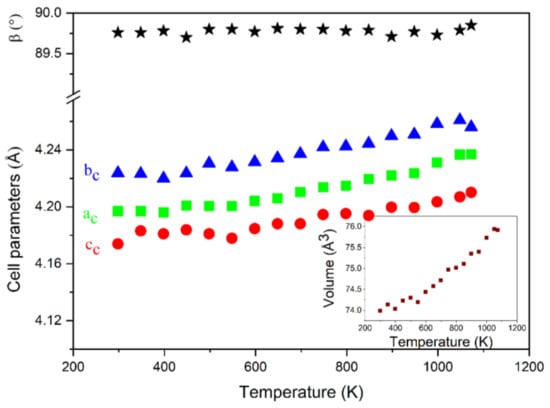
Figure 10.
Pseudocubic cell parameters in the function of temperature for (Ba0.2Sr0.8)PbO3.
These results are in opposition to those previously published. This is because [45] suggested that SrPbO3 does not accept the large Ba ions in the Sr sites and proposed that the limit of substitution is the (Ba0.2Sr0.8)PbO3 sample. In this paper, we proved that the (Ba0.2Sr0.8)PbO3 perovskite is a mono-phase well-crystalized sample that shows monoclinic P21/m distortion both at RT and in HT, ranging from 298 K to 1093 K.
3.3.2. (Ba0.3Sr0.7)PbO3 Ceramic Structure Both at RT and HT
The other examined sample doped with Ba2+ was (Ba0.3Sr0.7)PbO3. The crystalline structure of the (Ba0.3Sr0.7)PbO3 ceramic was determined at a wide range of temperatures, from 298 K to 1148 K. In Figure 11, the temperature evolution of significant diffraction lines such as {200}c and {222}c at selected temperatures are shown. The analysis of the observed lines at 298 K exhibited the presence of three lines of the {200}c and {220}c type and two lines of the {222}c type. That is to say, monoclinic distortion is observed for the crystal cell where the pseudocubic parameters are ac ≠ bc ≠ cc and β ≠ 90°. During the high-temperature evaluation of crystal structure behavior, the superstructure lines were observed. Their presence allowed for assigning the PbO6 tilting type to the corresponding crystal space group. The superstructure lines that were observed in the XRD pattern are caused by octahedral tilting. Tilts of the neighbouring octahedral were detected both in the same direction (+) and in the opposite direction (−), which is similar to that observed for (Ba0.3Sr0.7)PbO3. The presence of odd-odd-odd lines with k ≠ l, h ≠ l Miller indices such as (−153) and (−531), or (113) clearly indicates PbO6 octahedra tilting of the a− and c− type. The presence of (301), and (−323) superstructure lines with an odd-even-odd parity of reflections with h ≠ l indicates that b+-type tilting was observed. Furthermore, the presence of superstructure lines such as (124) and (212), (003) indicates that the displacement of Ba2+ and Sr2+ cations from their ideal positions is taking place. Therefore, both the cation displacement and octahedral tilt affect the distortions of the ideal perovskite cell.
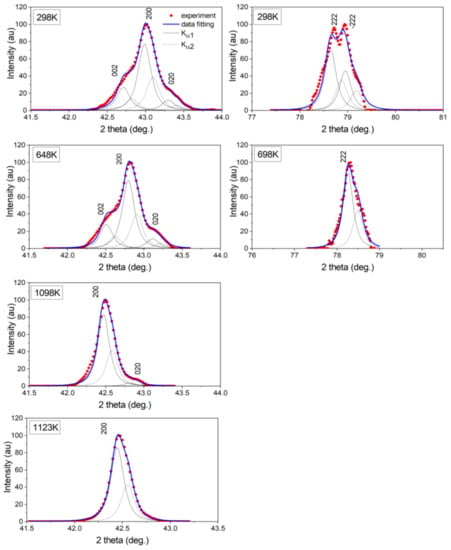
Figure 11.
Splitting of the main reflections {220}c and {200}c in different phases for (Ba0.3Sr0.7)PbO3.
For this reason, the pseudocubic cell of (Ba0.3Sr0.7)PbO3 can be described by a−b+c− notation by assigning the P21/m crystal group for pseudocubic cell parameters of ac ≠ bc ≠ cc and β ≠ 90°.
Further sample heating caused changes in the observed line positions and their number, as it is shown in Figure 11, indicating that structural phase transitions occurred. An analysis carried out at a temperature of 648 K showed the presence of two {200}c lines and one {222}c lines. During sample heating, one of two {222}c lines previously observed at RT has disappeared. Therefore, at 648 K, the first SPT occurred. This means that the monoclinic distortion observed in the crystal cell has transformed into an orthorhombic distortion. The temperature dependence of the pseudocubic cell parameters as a function of temperature is shown in Figure 12. The monotonic increase in the cell parameters is observed when the sample and SPT temperatures are indicated. Moreover, at 648 K, some superstructure lines were observed in the XRD pattern. The superstructure lines (120) and (−201) indicated the displacement of Ba2+ and Sr2+ cations from their ideal positions—(133) and (−113)—with octahedra tilting of the c− type, while (−251), (251) indicated the a+ type. Using Glazer’s notation, a+b0c− is obtained for (Ba0.3Sr0.7)PbO3, which indicates the Pmmn space group, with the pseudocubic cell parameters described as bc < ac ≠ cc. The second SPT (orthorhombic–tetragonal transition) was observed at about 1098 K, as shown in Figure 11 and Figure 12. It is interesting that the tetragonal phase exists in a very narrow temperature range (1098–1123 K), as shown in Figure 12. Moreover, when this SPT is taking place, both cell volume and the cell dimensions suddenly change. This behavior is different from that for (Ba0.2Sr0.8)PbO3 and SrPbO3. Right behind the tetragonal transformation, the cubic phase was observed at 1123 K. The average error for cell parameters determination was ±0.0032 Å for a, b, and c, while for β it was ±0.09° and for V it was ±0.11 Å3.
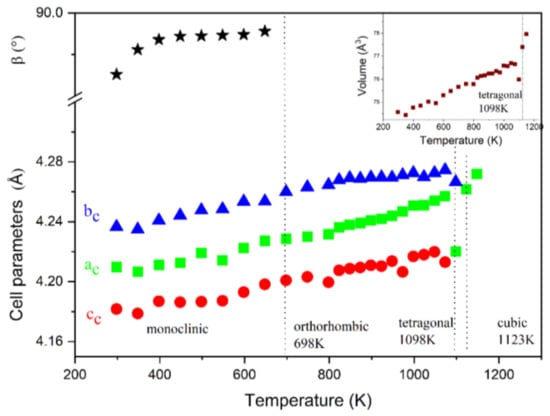
Figure 12.
Pseudocubic cell parameters in the function of temperature for (Ba0.3Sr0.7)PbO3.
3.4. Discussion on the Crystal Structure of the Oxide Strontium-Barium Perovskites Family
The results on the oxide strontium-barium perovskites family shown in this paper and those previously published [20,42] revealed that it is an interesting group in terms of the meaning of the crystal structure. Moreover, this discussion is applicable to the high-temperature thermoelectric oxide materials of the (Ba1−xSrx)PbO3 system, which is capable of converting high-temperature excess heat to electricity and proved to have high thermoelectric figures of merit [7,9].
Detailed X-ray diffraction tests were carried out for the first time for the system on the indicated complexity of the structure. As a result of the examinations, it is concluded that (Ba0.3Sr0.7)PbO3 perovskite represents the limit where the substitution of strontium by barium ions in the SrPbO3 ceramic demonstrates any structural phase transition. This is because for SrPbO3 and (Ba0.2Sr0.8)PbO3 ceramics, no temperature-induced structural phase transition was observed. It means that adding 20% Ba2+ to SrPbO3 did not affect the crystal structure. However, adding 30% Ba2+ made a large change, and three SPTs were observed. It is clear that this substitution significantly influenced the crystal structure and evidently the SPTs. In our previous work, a thermal analysis of the structure evolution of BaPbO3 substituted by Sr ions was carried out, while in the present work strontium-reached samples were examined. Based on the results of this paper and the previous reports, a comparison of two counterparts of the (Ba1−xSrx)PbO3 system together with the sample with composition can be conducted. The difference between the crystalline structure of BaPbO3 and SrPbO3 is easy to follow. Both structures are monoclinic distortions of the ideal cubic perovskite. BaPbO3 exhibits slight monoclinic distortion and symmetry, while SrPbO3 shows monoclinic distortion and orthorhombic symmetry. These distortions are mainly related to the tilting of the oxygen octahedral atom and, to a lesser extent, the A cations from their ideal positions. According to Glazer’s classification for BaPbO3, these are octahedra tilts of the a−b0c− type, while for SrPbO3 a−b+a− this tilting is strongly associated with the difference in ion size difference. The ionic radius of Sr2+ is smaller than that of Ba2+; they are RXIISr2+ = 1.44 Å and RXIIBa2+ = 1.61 Å, respectively. If cation A is smaller than the oxygen ions, the PbO6 octahedra may tilt towards one another to reduce the size of the cavity, which is occupied by cation A. This leads to an increase in tilt angle. PbO6 tilt angles were estimated for both materials and were equal to 10.74 and 11.02° for BaPbO3, while they were 11.89, 10.91, and 11.89° for SrPbO3 (Table 4). Furthermore, in both structures, Pb4+ ions occupy specific positions, remaining centrosymmetric. However, for the BaPbO3 compound, a small displacement of Ba2+ from its ideal position in the xz plane of ∆x = 0.0024 and ∆z = −0.0168 is observed. In contrast, Sr2+ ions in the SrPbO3 ceramic are moved towards the xy plane by about ∆x = 0.0054 and ∆y = −0.0405. It is clear that the displacement of Sr2+ ions is much greater than that of Ba2+ ions. It results in changes in PbO6 octahedra, and for BaPbO3 ceramics, the PbO6 octahedras are only slightly changed in shape. However, in SrPbO3, the material distortion of the structure is much larger due to the larger octahedral tilting angles, as can be seen in Figure 5. As a result, the Pb-O distance for SrPbO3 is 2.287 (2) Å, while for BaPbO3, it is 2.151 (8) Å. The cell parameters of SrPbO3 are smaller compared to BaPbO3. The angles of OI-Pb-OII and OII-Pb-OII for SrPbO3 are 85.5 (6)°, 94.4 (3)°, and 90.7 (4)°, respectively, and for BaPbO3 OI-Pb-OII, OII-Pb-OIII and OI-Pb-OIII they are 87.1 (7)°, 90.4 (0)°, and 88.1 (2)°. It is clear that for SrPbO3 the deviation from the 90° angle is much higher (Table 4). When examining the sample with x = 0.5, where equal amounts of Ba2+ and Sr2+ ions were incorporated into the crystal structure, the values of angles of octahedra tilting were, as expected, an average value for their counterparts. Furthermore, when Sr2+ was added to pure BaPbO3, an additional tilt was observed [42], as can be seen in Table 4.
Furthermore, the comparison shows that barium substitution with strontium in the BaPbO3 ceramic results in a decrease in the structure tolerance factor. As the data from the literature showed, for BaPbO3 τ was equal to 0.985 [20], while for (Ba0.5Sr0.5)PbO3 it was 0.957 [42] and for SrPbO3 it was 0.928. This change may be an indication of possible crystal structure deviations, and greater distortion may be expected. This was supported experimentally (Table 4). For BaPbO3, there are two types of octahedral tilting in the opposite direction (−) that can be described as a−b0c−. For (Ba0.5Sr0.5)PbO3, there appears to be additional tilting in the same direction (+) a−a−c+, while for the SrPbO3 sample, there is the a−b+a− tilting type.
The data from the present work and previous papers [20,42] on crystal structure as a function of temperature enabled us to gain a complete understanding of the (Ba1−xSrx)PbO3 perovskite system. It should be emphasized that in this work detailed data were shown specifically for (Ba0.3Sr0.7)PbO3, (Ba0.2Sr0.8)PbO3 and SrPbO3 samples. The extended study enabled the evaluation of the temperature behavior of the crystal structure. As a result of this wide-ranging study, based on the recent and already published co-authored papers, Figure 13 shows pseudocubic cell parameters as a function of composition for the whole (Ba1−xSrx)PbO3 family. Since interesting results were obtained for the concentrations of Sr2+ ions (x = 0, 0.2, 0.5, 0.8, and 1.0, etc.), additional samples (of 0.1 and 0.9, etc.) were additionally produced. Due to the fact that an enormous amount of data was collected during the extensive research, only some data were shown in the manuscript. Consequently, this has resulted in the preparation of Figure 13 and Figure 14.
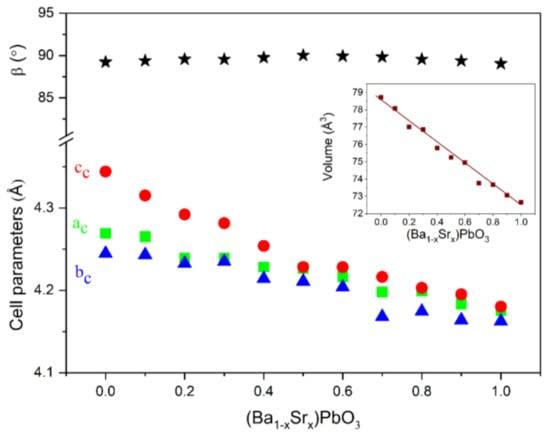
Figure 13.
The pseudocubic cell parameters in function of composition for (Ba1−xSrx)PbO3 system.
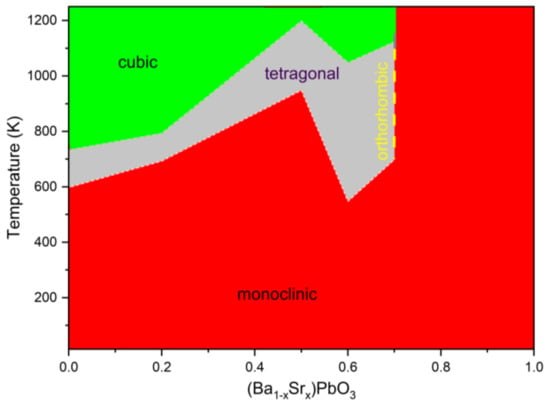
Figure 14.
Phase diagram for (Ba1−xSrx)PbO3 system.
It is clear that the addition of Sr2+ ions to BaPbO3 led to a decrease in cell parameters as the amount of Sr increased in the sample. It can be seen that the difference between pseudocubic parameters ac, bc, and cc also slowly decreased with the substitution degree. For the sample (Ba0.5Sr0.5)PbO3 with x = 0.5, all three pseudocubic parameters are almost equal. This behavior may result from equal amounts of both Ba2+ and Sr2+ ions. This caused a type of competition between these two ions, which were substituting the same ion place, finally leading to almost the same pseudocubic cell parameter values. For the (Ba1−xSrx)PbO3 system, which is found to be practically attractive due to its metallic conduction and semiconduction properties, the mobility of electrons was seriously influenced by the randomness of cations at the A-site [35]. In fact, the resistivity increased with x and the metallic behavior disappeared for the (Ba0.5Sr0.5)PbO3 sample. This is because the carrier concentration decreased rapidly when x > 0.5 and the mobility of electrons in the(Ba1−xSrx)PbO3 system showed a minimum at x = 0.5. Because the substitution of Ba2+ by Sr2+ ions leads to the lattice, it also leads to the change in the local symmetry of the octahedra. The overlap between the Pb 6s and O 2p orbitals is the origin of the metallic conductivity of this system. Since the local symmetry of PbO6 octahedra is changed, it results in the narrowing of the Pb 6s-O 2p conduction band, and finally, it affects the density of states in the Fermi surface.
Analogously, the inlet in Figure 13 shows, that the volume of the pseudocubic cell changed linearly with the degree of substitution. The analysis of the XRD pattern at RT showed that the distortion for SrPbO3 was significantly bigger than that observed for BaPbO3, with middle values for intermediate compositions.
What is fundamental is that the XRD, together with SEM-EDS data, proved that it was possible to obtain good-quality monophase samples, which is in opposition to some previous reports [45]. Furthermore, it is also the first time that such a wide-temperature study has been carried out. The obtained results from X-ray powder diffraction measurements allowed us to prepare the phase diagram for (Ba1−xSrx)PbO3 samples, which is shown in Figure 14. In Figure 14, three regions, namely monoclinic (red area), tetragonal distortion (grey area), and cubic (green area), are marked. The phase diagram is built based on a careful investigation, covering temperatures in the 14–1148 K range and substitution levels from 0 to 1.0 in the (Ba1−xSrx)PbO3 system. Taken together, the data obtained in the presented work and the data obtained in the previous papers enabled us to build this diagram. Lower-temperature studies proved that the system exists as a monoclinic distortion of the perovskite cell in the whole substitution range. Moreover, at room temperature, all studied ceramics showed monoclinic distortion. It is clear that the monoclinic distortion is dominant when looking closely at the diagram. When the temperature increases, monoclinic-tetragonal phase transitions occur for substitutions of 0 to 0.7. For example, for parent ceramic BaPbO3, monoclinic distortion existed up to 598 K; for substituted (Ba0.8Sr0.2)PbO3, it existed up to 693 K; for (Ba0.5Sr0.5)PbO3 it was up to 948 K; and for (Ba0.4Sr0.6)PbO3 and (Ba0.3Sr0.7)PbO3 ceramics it was, respectively, 548 K and 1098 K. On this basis, it can be concluded that the temperature of the structural phase transition increases while increasing the amount of Sr2+ in the sample, except for in the (Ba0.4Sr0.6)PbO3 sample, which is not clear. The detected tetragonal phase (a grey area) is rather narrow for the system. Furthermore, similar behavior is also observed when the experimental temperature is increased, where the tetragonal-cubic transition occurs. For barium-rich samples such as BaPbO3 or (Ba0.8Sr0.2)PbO3, cubic phases exist as low as 733 K and 793 K. Cubic structure is observed for (Ba1−xSrx)PbO3 materials where x = 0–0.7. For ceramics with x > 0.7, no structural temperature-induced phase transitions are observed during pendant heating.
The detailed explanation of the relationship between structural distortions of the (Ba1−xSrx)PbO3 materials, together with transitions and physical properties, is included below. The BaPbO3 dense ceramic was proposed as an electrode material for ferroelectric thin films [35,46,47]. For the temperature-dependence of thermal conductivity, a decrease in the value was observed at ca. 450 °C (723 K) [46]. This behavior correlates well with our data, which showed that at 733 K (460 °C) a tetragonal-cubic transition occurs. SrPbO3 is known as a n-type narrow-bandgap semiconductor, exhibiting a semiconducting behavior that is ascribed to the electropositive character of Sr and the constancy of the valence band energy of O2−:2p parentage. SrPbO3 offers the possibility of constructing solar devices [47]. It reported that the weak hybridization of the PbO bond, due to the tilting of the octahedra, beneficially reduces the energy of the antibonding conduction band, resulting in a small optical gap Eg (1.76 eV). For this reason, the following features allow the material to be used in solar energy conversion: sufficient negative potential Vfb, an optical gap value close to the optimal value required for terrestrial applications, and good chemical stability, which is proved in our experiments. During the heating, the SrPbO3 ceramic structure with monoclinic distortion is stable without decomposing (Figure 14). However, the maximum working temperature cannot exceed 1093 K, as demonstrated.
In Figure 15, simultaneous thermal analysis data are shown for selected perovskites of the (Ba1−xSrx)PbO3 system. A 5 mg sample was analyzed in each case within the conditions described in the experimental section. Figure 15a,b shows the experimental data for the two non-doped perovskites, i.e., BaPbO3 and SrPbO3, respectively. The mass changes of the samples were observed in the given regions where structural phase transitions appeared. It is clear to see small slopes in masses, shown in the circles, supporting SPT for BaPbO3. The existence of the phases, namely by the structural distortion of ideal perovskites, is shown by diverse fields with different patterns filled. However, it should be noted that there were no changes in temperature (DSC) observed while SPT occurred, nor when the initial mass of the sample was changed from 5 to 20 or 200 mg. Furthermore, when the structural phase transitions were not detected by XRD study, they were also not observed in STA examinations, as shown, for example, for the SrPbO3 material. The thermal analyzer used in this research was a valuable tool with great accuracy and sensitivity, enabling supporting observations from powder diffraction. As a consequence, this supplementary testing supported the XRD data and enabled the preparation of the phase diagram.
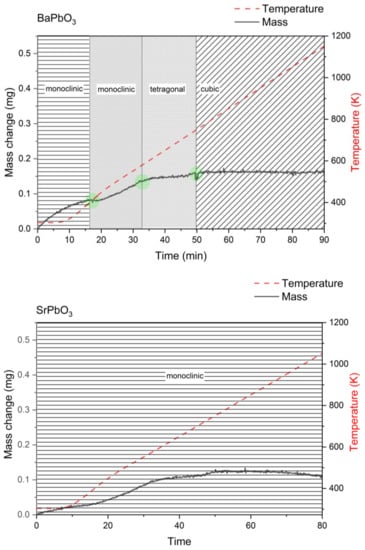
Figure 15.
STA analysis for selected examples of BaPbO3 and SrPbO3 perovskites.
3.5. Potential Application in Different Processes
The literature study showed that no prior experiments determined that feature perovskites (Ba,SrPbO3) where tested as oxygen carriers (OCs). In this experiment, the selected samples (SrPbO3, BaPbO3, and Ba0.9Sr0.1PbO3) were used as an OC for solid fuel combustion. Preliminary tests have been performed using graphite as an initial fuel. Tests with graphite proved that combustion with fuel is possible at temperatures as low as 800 °C (1073 K); however, reaction occurs very slowly, and fuel conversion rates were low. At 900 °C (1173 K), the fuel conversion of graphite reached almost 100%. However, sample SrPbO3 melted in this temperature, and XRD analysis showed the decomposition of this material. Therefore, for the next investigation with this material, the sample was tested at a lower temperature 850 °C (1123 K). In Figure 14, SrPbO3 shows a maintained monoclinic structure in our temperature measurement range, while more barium-rich perovskites underwent phase transition to tetragonal, and finally cubic, structures at higher temperatures. This might indicate that monoclinic perovskites of this series are less temperature-stable. In the next step, the analysis was performed with the Illinois#6 hard coal to check the perovskite performance in the chemical looping combustion (CLC) process with a real fuel. The TGA analysis revealed that the mass changed throughout the time of the combustion at 850 and 900 °C (1173 K) (Figure 16). The graphs also provide additional data from mass spectrometry (QMS) that show the production of H2O and CO2 during the process. The emission of those gases corresponds to mass changes observed during TGA experiments, which supports that the combustion process took place. The combustion occurs in several stages, which is clear from Figure 16. Using the TGA data, the amount of oxygen release was calculated for the samples. For SrPbO3, BaPbO3, and Ba0.9Sr0.1PbO3, values were 2.6, 2.8, and 3.6 wt.%, respectively. The materials were also regenerated by using a stream of air. The regeneration showed faster kinetics (green area) compared to the combustion process (grey area).
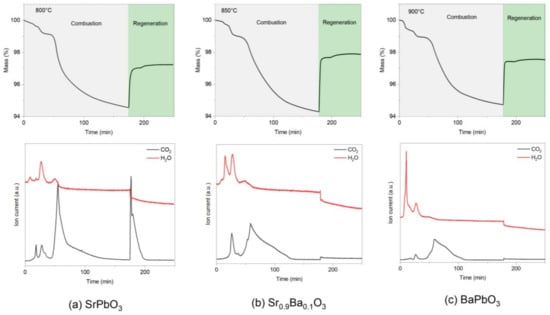
Figure 16.
TGA-QMS analysis for selected samples of SrPbO3, Ba0.9Sr0.1PbO3 and BaPbO3 perovskites.
Due to the low melting temperature for the SrPbO3 sample, the combustion of the fuel was not performed effectively at some temperatures. For example, in Figure 16a, the high peak of CO2 is presented during regeneration, which means not all coal was combusted completely at 850 °C (1123 K). However, for BaPbO3, which is more thermally stable, total hard coal combustion was observed even as high 900 °C (1173 K) (Figure 16c). This is distinguished by elevated CO2 peaks during combustion and the lack of a CO2 peak in the regeneration stage. When barium was added to SrPbO3, an improvement in thermal stability and reactivity were observed (Figure 16b). The Ba0.9Sr0.1PbO3 might be indicated as the promising sample for CLC application. Consequently, the high content of barium increases the temperature resistivity; moreover, a small addition of strontium provides a beneficial reactivity rate. Therefore, the Sr-doped material showed the better performance with the Illinois#6 hard coal.
4. Conclusions
In conclusion, this paper covers a complementary and detailed study of the structural properties of (Ba1-xSrx)PbO3. XRD was used for the investigations of ceramics implemented in practice as high-performance oxide ceramics used as high-temperature thermoelectric energy-conversion materials or for preventing the corrosion of long-life batteries. The crystalline structure and the temperature-dependent variation of the series were determined for the first time by obtaining good-quality samples, which were also proved by SEM–EDS examination. The type of distortion and symmetry of the synthesized perovskites were determined in a wide range of temperatures, from 14 K to 1148 K. The types of splitting and the numbers of the main diffraction lines, which are produced by different sequences of the tilts of the oxygen octahedral, were analyzed. For each symmetry, the parameters of the crystalline structure were determined. Several samples from the (Ba1−xSrx)PbO3 series were selected, such as (Ba0.3Sr0.7)PbO3, (Ba0.2Sr0.8)PbO3 and SrPbO3. On the basis of that, the crystal structure distortion of SrPbO3 was monoclinic at RT. XRD measurements carried out for SrPbO3 over a wide temperature range did not confirm any occurrence of structural phase transitions, as previously suggested in the literature. The limit of substitution was determined for the substitution of ions in site A, for which structural phase transitions are still observed at 30% of Ba and 70% of Sr. Thus, for the (Ba0.2Sr0.8)PbO3 perovskite, no structural changes are observed. This sample was stable over a broad temperature range and exhibited monoclinic distortion.
Furthermore, in this work, simultaneous thermogravimetry–differential scanning calorimetry and STA/TG-DSC were applied. The instrument was also coupled to a quadrupole mass spectrometer (QMS). The thermal analysis examinations for obtained perovskites supported both XRD and EDS findings. This comprehensive study was essential and supported the observations of SPTs, as well as the great thermal stability of perovskites, together with ceramics composition.
What is fundamental, is that the XRD, together with SEM-EDS examination data, proved that it was possible to obtain mono-phase samples of good quality, which is in opposition to some reports. Furthermore, it is also the first time that such a wide-temperature study has been carried out. Structural phase transitions were observed for solid solutions of (Ba1−xSrx)PbO3 and were described in detail, allowing for the preparation of the phase diagram.
A detailed explanation of the relationship between structural distortions of the materials and the physical properties is included in this paper. Practically, our study proved that the materials are stable even at a temperature as high as ca. 1050 K for strontium-rich samples, such as (Ba0.2Sr0.8)PbO3 or SrPbO3, as well as more resistant. This temperature was proven to be ca. 1200 K for barium-rich samples such as (Ba0.4Sr0.6)PbO3 and (Ba0.5Sr0.5)PbO3, without decomposition. Stable performance is possible even for a high degree of substitution due to the shift of cations from their ideal positions and octahedral titling. These ceramics are examples of thermoelectric oxide materials that are capable of converting high-temperature excess heat to electricity. Furthermore, some ceramics, such as optically active semiconductor oxides such as SrPbO3 or (Ba0.2Sr0.8)PbO3, offer the possibility of constructing solar devices; by the conversion of light, electrical energy can be generated.
In this paper, for the first time, the investigation of a new application was presented for the (Ba1−xSrx)PbO3 family. The TGA analysis was performed with Illinois#6 hard coal to check perovskites performance in the chemical looping combustion (CLC) process. Finally, Ba0.9Sr0.1PbO3 was indicated to have the most potential for application as an oxygen carrier due to its thermal stability and reactivity.
Author Contributions
E.K.: conception of the work, samples synthesis, XRD and SEM-EDS experiments and analysis, manuscript writing, R.L.: STA acquisition and TGA-QMS data analysis, M.A.: language correction and formatting, drafting the TGA work. All authors have read and agreed to the published version of the manuscript.
Funding
This research received no external funding.
Conflicts of Interest
The authors declare no conflict of interest.
References
- Lee, S.; Cho, J.S.; Kang, D.W. Perovskite/Polyethylene Oxide Composites: Toward Perovskite Solar Cells without Anti-Solvent Treatment. Ceram. Int. 2019, 45, 23399–23405. [Google Scholar] [CrossRef]
- Geffroy, P.M.; Vivet, A.; Guironnet, L.; Richet, N.; Rossignol, F.; Chartier, T. Perovskite Foams Used in Combination with Dense Ceramic Membranes for Oxygen Transport Membrane Applications. Ceram. Int. 2018, 44, 19831–19835. [Google Scholar] [CrossRef]
- Rosa Silva, E.; Nicolini, J.V.; Yamauchi, L.; Machado, T.M.; Curi, M.; Furtado, J.G.; Secchi, A.R.; Ferraz, H.C. Carbon-Based Electrode Loaded with Y-Doped SrTiO3 Perovskite as Support for Enzyme Immobilization in Biosensors. Ceram. Int. 2020, 46, 3592–3599. [Google Scholar] [CrossRef]
- Haye, E.; Capon, F.; Barrat, S.; Boulet, P.; Andre, E.; Carteret, C.; Bruyere, S. Properties of Rare-Earth Orthoferrites Perovskite Driven by Steric Hindrance. J. Alloys Compd. 2016, 657, 631–638. [Google Scholar] [CrossRef]
- Huang, L.; Xu, J.; Sun, X.; Li, C.; Xu, R.; Du, Y.; Ni, J.; Cai, H.; Li, J.; Hu, Z.; et al. Low-Temperature Photochemical Activation of Sol-Gel Titanium Dioxide Films for Efficient Planar Heterojunction Perovskite Solar Cells. J. Alloys Compd. 2018, 735, 224–233. [Google Scholar] [CrossRef]
- Zdorovets, M.; Kozlovskiy, A.; Arbuz, A.; Tishkevich, D.; Zubar, T.; Trukhanov, A. Phase Transformations and Changes in the Dielectric Properties of Nanostructured Perovskite-like LBZ Composites as a Result of Thermal Annealing. Ceram. Int. 2020, 46, 14460–14468. [Google Scholar] [CrossRef]
- Itoh, M.; Sawada, T.; Kim, I.S.; Inaguma, Y.; Nakamura, T. Electrical Properties of the A(Pb1−xBx)O3−δ (A = Ba, Sr, B = Sb, Bi) System. Phys. C Supercond. 1992, 204, 194–202. [Google Scholar] [CrossRef]
- Che, W.; Wei, M.; Sang, Z.; Ou, Y.; Liu, Y.; Liu, J. Perovskite LaNiO3-δ Oxide as an Anion-Intercalated Pseudocapacitor Electrode. J. Alloys Compd. 2018, 731, 381–388. [Google Scholar] [CrossRef]
- Drozd, V.A.; Ekino, T.; Gabovich, A.M.; Pȩkała, M.; Ribeiro, R.A.; Shevchenko, A.D.; Uvarov, V.M. Current Carrier Localization and Coulomb Gap Observed inSrPbO3−δ by Transport Measurements and Tunnel Spectroscopy. J. Phys. Condens. Matter. 2005, 17, 7407. [Google Scholar] [CrossRef]
- Oanh Vu, T.K.; Kim, Y.H.; Ahn, C.W.; Kim, M.H.; Han, I.K.; Kim, E.K. Optimization of Optoelectrical Properties during Synthesizing Methylammonium Lead Iodide Perovskites via a Two-Step Dry Process. J. Mater. Res. Technol. 2021, 14, 1–9. [Google Scholar] [CrossRef]
- Rajeswari, R.; Islavath, N.; Raghavender, M.; Giribabu, L. Recent Progress and Emerging Applications of Rare Earth Doped Phosphor Materials for Dye-Sensitized and Perovskite Solar Cells: A Review. Chem. Rec. 2020, 20, 65–88. [Google Scholar] [CrossRef]
- Zhang, C.; Zeng, K.; Wang, C.; Liu, X.; Wu, G.; Wang, Z.; Wang, D. LaMnO3 Perovskites via a Facile Nickel Substitution Strategy for Boosting Propane Combustion Performance. Ceram. Int. 2020, 46, 6652–6662. [Google Scholar] [CrossRef]
- Qiu, J.; Yang, S. Material and Interface Engineering for High-Performance Perovskite Solar Cells: A Personal Journey and Perspective. Chem. Rec. 2020, 20, 209–229. [Google Scholar] [CrossRef]
- Zhuang, S.; Han, N.; Chen, R.; Yao, Z.; Zou, Q.; Song, F. Perovskite Oxide Based Composite Hollow Fiber Membrane for CO2 Transport. Ceram. Int. 2020, 46, 2538–2544. [Google Scholar] [CrossRef]
- Zhang, H.; Guan, D.; Gao, X.; Yu, J.; Chen, G.; Zhou, W.; Shao, Z. Morphology, Crystal Structure and Electronic State One-Step Co-Tuning Strategy towards Developing Superior Perovskite Electrocatalysts for Water Oxidation. J. Mater. Chem. A 2019, 7, 19228–19233. [Google Scholar] [CrossRef]
- Das, N.; Kumar, S.; Kumar, V.; Jain, N.; Singh, S.; Gupta, L.C.; Ganguli, A.K. LnFe0.5Cr0.5O3 Based Perovskites Showing Multiferroic Properties and Polarization Induced Photoelectrochemical Activity. J. Solid State Chem. 2021, 299, 122200. [Google Scholar] [CrossRef]
- Ksepko, E. Perovskite Sr(Fe1-XCux)O3-δ Materials for Chemical Looping Combustion Applications. Int. J. Hydrogen Energy 2018, 43, 9622–9634. [Google Scholar] [CrossRef]
- Ksepko, E.; Lysowski, R. Effective Direct Chemical Looping Coal Combustion Using Bimetallic Ti-Supported Fe2O3-MnO2 Oxygen Carriers. Greenh. Gases Sci. Technol. 2023. [Google Scholar] [CrossRef]
- Ksepko, E.; Lysowski, R. Extremely Stable and Durable Mixed Fe–Mn Oxides Supported on ZrO2 for Practical Utilization in CLOU and CLC Processes. Catalysts 2021, 11, 1285. [Google Scholar] [CrossRef]
- Ksepko, E.; Ratuszna, A. Crystal Structure and Temperature Dependent Structural Phase Transitions in (Ba1-XSrx)PbO3 (X = 0, 0.2, 0.6) Perovskite Ceramics. Ceram. Int. 2018, 44, 18294–18302. [Google Scholar] [CrossRef]
- Li, C.; Wang, A.; Xie, L.; Deng, X.; Liao, K.; Yang, J.A.; Li, T.; Hao, F. Emerging Alkali Metal Ion (Li+, Na+, K+ and Rb+) Doped Perovskite Films for Efficient Solar Cells: Recent Advances and Prospects. J. Mater. Chem. A 2019, 7, 24150–24163. [Google Scholar] [CrossRef]
- Qin, C.; Matsushima, T.; Klotz, D.; Fujihara, T.; Adachi, C.; Qin, C.; Matsushima, T.; Adachi, C.; Klotz, D.; Fujihara, T. The Relation of Phase-Transition Effects and Thermal Stability of Planar Perovskite Solar Cells. Adv. Sci. 2019, 6, 1801079. [Google Scholar] [CrossRef] [PubMed]
- Soliman, N.K. Factors Affecting CO Oxidation Reaction over Nanosized Materials: A Review. J. Mater. Res. Technol. 2019, 8, 2395–2407. [Google Scholar] [CrossRef]
- Yasukawa, M. High-Temperature Thermoelectric Properties of the Solid Solutions BaBi1−x Pbx O3 (X = 0−1). J. Mater. Sci. Lett. 2001, 20, 1493–1495. [Google Scholar] [CrossRef]
- Shin, W.; Murayama, N.; Ikeda, K.; Sago, S. Thermoelectric Power Generation Using Li-Doped NiO and (Ba, Sr)PbO3 Module. J. Power Sources 2001, 103, 80–85. [Google Scholar] [CrossRef]
- Shin, W.; Murayama, N.; Ikeda, K.; Sago, S.; Terasaki, I. Thermoelectric Device of Na(Co, Cu)2O4 and (Ba, Sr)PbO3. J. Ceram. Soc. Japan 2002, 110, 727–730. [Google Scholar] [CrossRef]
- Kao, W.; Haberichter, S.L.; Bullock, K.R. Corrosion Resistant Coating for a Positive Lead/Acid Battery Electrode. J. Electrochem. Soc. 1992, 139, L105–L107. [Google Scholar] [CrossRef]
- Shannon, R.D. Unit Cell and Space Group of SrPbO3. J. Solid State Chem. 1971, 3, 184–185. [Google Scholar] [CrossRef]
- Keller, H.L.; Meier, K.H.; Müller-Buschbaum, H. Zur Kristallstruktur von SrPbO3. Zeitschrift fur Naturforsch.-Sect. B J. Chem. Sci. 1975, 30, 277–278. [Google Scholar] [CrossRef]
- Ritter, H.; Ihringer, J.; Maichle, J.K.; Prandl, W.; Hoser, A.; Hewat, A.W. The Crystal Structure of the Prototypic Ceramic Superconductor BaPbO3: An X-ray and Neutron Diffraction Study. Z. Für Phys. B Condens. Matter. 1989, 75, 297–302. [Google Scholar] [CrossRef]
- Shuvaeva, E.T.; Fesenko, E. Synthesis And X-ray Investigation of Perovskites BaPbO3 and SrPbO3-Sov. Phys. Crystallogr. 1970, 15, 321. [Google Scholar]
- Hester, J.R.; Howard, C.J.; Kennedy, B.J.; Macquart, R. High-Temperature Structural Studies of SrPbO3 and BaPbO3. Aust. J. Chem. 2002, 55, 543–545. [Google Scholar] [CrossRef]
- Lobanov, M.V.; Kopnin, E.M.; Xenikos, D.; Grippa, A.J.; Antipov, E.V.; Capponi, J.J.; Marezio, M.; Julien, J.P.; Tholence, J.L. Synthesis and Resistivity Properties of Sr1−XLaxPbO3-δ and SrPb1−XBixO3−δ. Mater. Res. Bull. 1997, 32, 983–992. [Google Scholar] [CrossRef]
- Fu, W.T.; Ijdo, D.J.W. A Comparative Study on the Structure of APbO3 (A = Ba,Sr). Solid State Commun. 1995, 95, 581–585. [Google Scholar] [CrossRef]
- Itoh, M.; Sawada, T.; Kim, I.S.; Inaguma, Y.; Nakamura, T. Composition Dependence of Carrier Concentration and Conductivity in (Ba1−xSrx)PbO3−δ System. Solid State Commun. 1992, 83, 33–36. [Google Scholar] [CrossRef]
- Murayama, N.; Yasukawa, M. High Temperature Thermoelectric Properties of Ba1-XSrxPbO3 (0 ≤ x ≤ 1.0). In Proceedings of the Seventeenth International Conference on Thermoelectrics, Proceedings ICT98, Nagoya, Japan, 28 May 1988; IEEE: New York, NY, USA, 1988; pp. 563–566. [Google Scholar]
- Keester, K.L.; White, W.B. Crystal Chemistry and Properties of Phases in the System SrO-PbO-O. J. Solid State Chem. 1970, 2, 68–73. [Google Scholar] [CrossRef]
- Thornton, G.; Jacobson, A.J. A Powder Neutron Diffraction Determination of the Structure of BaPbO3 at 4.2 K. Mater. Res. Bull. 1976, 11, 837–841. [Google Scholar] [CrossRef]
- Moussa, S.M.; Kennedy, B.J.; Vogt, T. Structural Variants in ABO3 Type Perovskite Oxides. On the Structure of BaPbO3. Solid State Commun. 2001, 119, 549–552. [Google Scholar] [CrossRef]
- He, J.; Li, T.; Liu, X.; Su, H.; Ku, Z.; Zhong, J.; Huang, F.; Peng, Y.; Cheng, Y.B. Influence of Phase Transition on Stability of Perovskite Solar Cells under Thermal Cycling Conditions. Sol. Energy 2019, 188, 312–317. [Google Scholar] [CrossRef]
- Tao, S.; Irvine, J.T.S. Discovery and Characterization of Novel Oxide Anodes for Solid Oxide Fuel Cells. Chem. Rec. 2004, 4, 83–95. [Google Scholar] [CrossRef]
- Ksepko, E.; Winiarski, A.; Ratuszna, A. X-ray Powder Diffraction Study of Structural Phase Transitions in (Ba0.5Sr0.5)PbO3 Perovskite. Phase Transit. 2004, 77, 335–344. [Google Scholar] [CrossRef]
- Shao, D.; Hutchinson, E.J.; Heidbrink, J.; Pan, W.P.; Chou, C.L. Behavior of Sulfur during Coal Pyrolysis. J. Anal. Appl. Pyrolysis 1994, 30, 91–100. [Google Scholar] [CrossRef]
- Woodward, P.M. Octahedral Tilting in Perovskites. I. Geometrical Considerations. Acta Crystallogr. Sect. B Struct. Sci. 1997, 53, 32–43. [Google Scholar] [CrossRef]
- Jorda, J.L.; Lebbou, K.; Galez, P.; Abraham, R. Solid State Equilibrium in the Doubly Substituted (TI, Pb)(Sr, Ba)O3 System. J. Alloys Compd. 1997, 256, 34–39. [Google Scholar] [CrossRef]
- Azuma, T.; Sakamoto, Y.; Takahashi, S.; Kuwabara, M. Preparation of Dense BaPbO3 Ceramic Electrode Materials for Ferroelectric Thin Films and Their Electrical and Thermal Properties. J. Ceram. Soc. Japan 1994, 102, 2369–2380. [Google Scholar] [CrossRef]
- Hadjarab, B.; Saadi, S.; Bouguelia, A.; Trari, M. Physical Properties and Photoelectrochemical Characterization of SrPbO3. Phys. Status Solidi 2007, 204, 2369–2380. [Google Scholar] [CrossRef]
Disclaimer/Publisher’s Note: The statements, opinions and data contained in all publications are solely those of the individual author(s) and contributor(s) and not of MDPI and/or the editor(s). MDPI and/or the editor(s) disclaim responsibility for any injury to people or property resulting from any ideas, methods, instructions or products referred to in the content. |
© 2023 by the authors. Licensee MDPI, Basel, Switzerland. This article is an open access article distributed under the terms and conditions of the Creative Commons Attribution (CC BY) license (https://creativecommons.org/licenses/by/4.0/).